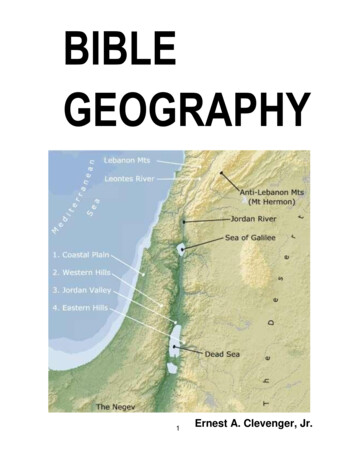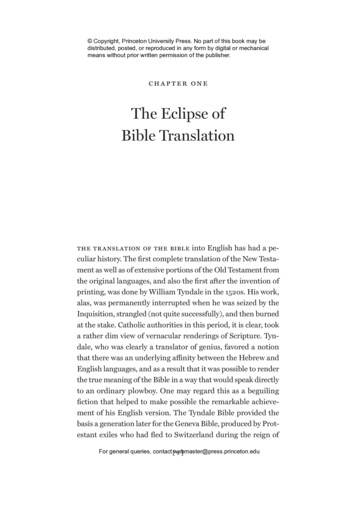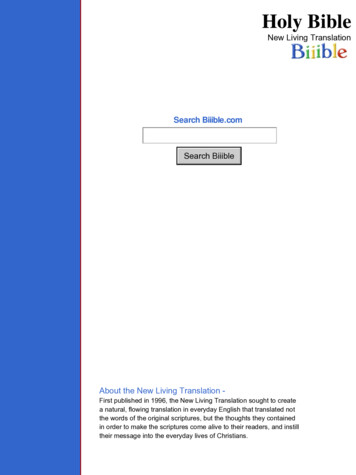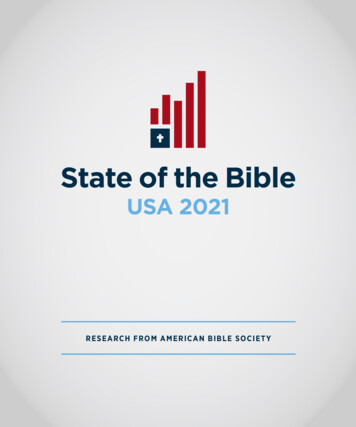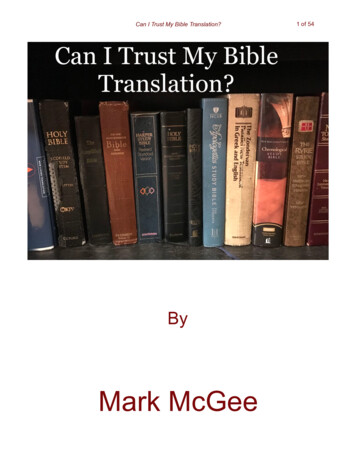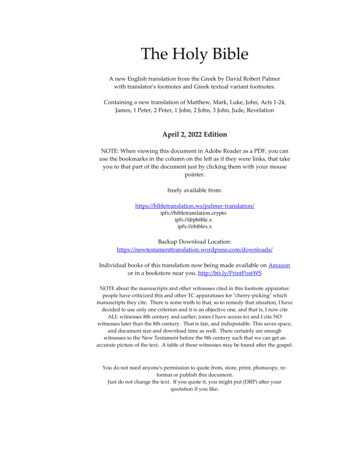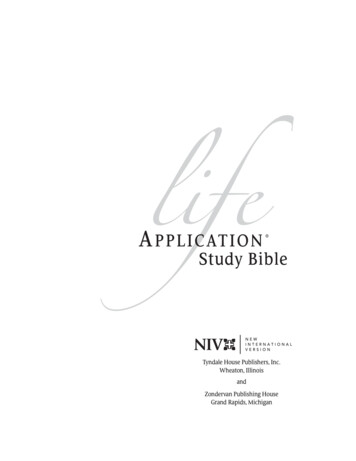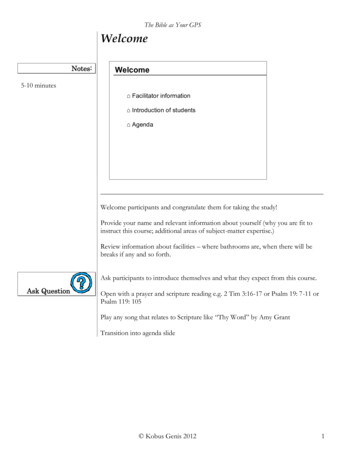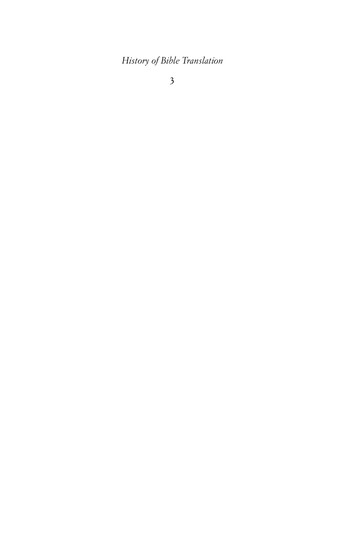
Transcription
History of Bible Translation3
HISTORY OF BIBLE TRANSLATIONPhilip H. TownerDean of the Nida Institute for Biblical ScholarshipPhilip A. NossSeries Editor1. A History of Bible Translation, edited by Philip A. Noss.2. Early Scriptures of the Gold Coast (Ghana): The Historical, Linguistic,and Theological Settings of the Gã, Twi, Mfantse, and Ewe Bibles, byJohn David Kwamena Ekem.3 A Restless Search: A History of Persian Translations of the Bible, byKenneth J. Thomas.4. God Speaks Our Language: A History of Bible Translation in EastAfrica, 1844–Present, by Aloo Mojola.Also of interestA Dictionary of Bible Translation, edited by Philip A. Noss.
NIDA INSTITUTE FOR BIBLICAL SCHOLARSHIPAMERICAN BIBLE SOCIETYA RESTLESS SEARCHA History of Persian Translations of the Bibleby KENNETH J. THOMASwith a contribution byALI-ASGHAR AGHBAR
First Edition 2015 2015 American Bible SocietyISBN paperback: 978-1-94409-200-9ISBN hardcover: 978-1-94409-202-3Distributed by SBL Press, Atlanta, GeorgiaOnline: http://www.sbl-site.org/All rights reserved. No part of this work may be reproduced or transmitted in any form or by any means, electronic or mechanical, including photocopying and recording, or by means of any information storageor retrieval system, except as may be expressly permitted by the 1976Copyright Act or in writing from the publisher. Requests for permissionshould be addressed in writing to the Rights and Permissions Office, SBLPress, 825 Houston Mill Road, Atlanta, GA 30329 USA.All art in this volume is from the Collection of the American Bible Societyunless noted otherwise. Used by permission.
Then King Darius made a decree,and they searched the archiveswhere the documents were stored in Babylon.Ezra 6:1 NRSV if you indeed cry out for insight,and raise your voice for understanding;if you seek [wisdom] like silver,and search for it as for hidden treasures—then you will understand the fear of the LORDand find the knowledge of God.Proverbs 2:3–5 NRSVYou search the Scriptures because you thinkin them you have eternal life.John 5:39 NRSV
CONTENTSAbbreviationsFigures and PlatesForewordPrefaceIXXIIIXVxIXINTRODUCTION1. From the Fifth Century to the Future: An Introduction3PART I2. Along the Silk Road: The Parthian and Sassanian Eras(129 B.C.E.–651 C.E.)133. Finds in Treasure Troves: The Early Islamic Era (651–1055)43Excursus 1. Pahlavi Persian Vocabulary654. A First Flourishing of Translations: The Mongol Era (1256–1343) 67Excursus 2. A Persian Translation Compared with the Syriac Peshitta 1055. Kings and a Multifaith Cast of Translators: The Safavid Era(1501–1736)1096. Reluctant Translators: The Afshar Era (1736–1795)1457. The Company and the Bible Society: The Qajar Era (1796–1925) 167Excursus 3: Distributing Bible Translations: The Role of the BibleSocietes232
VIIIA RESTLESS SEARCH8. New Approaches: The Pahlavi Era (1925–1979)2379. A Profusion of Translations: The Era of the Islamic Republic(1979–2010)273PART II10. Translators, Sponsors, and Their AudiencesExcursus 4: Versification of Biblical Texts31934911. Shifting Lexical Choices35312. Comparative Stylistic Analyses37113. Textual Choices and Their Theological Implications40914. Trends in Translation: From the Fifth Century to theTwenty-First419Appendix A: Chronology of Persian Translations of the BibleAppendix B: History of Iran and World Events TimelineAppendix C: Translations TimelineAppendix D: Sample Persian TranslationsBibliographyGlossaryCreditsIndex to Scripture References and Other Ancient TextsSubject Index435449451453457483489491497
ABBREVIATIONSBIBLES, VERSIONS, AND ANCIENT English Standard VersionHebrew textKing James VersionJerusalem BibleSeptuagintMasoretic TextNew International VersionNew Jerusalem BibleNew Living TranslationNew Millennium VersionNew Revised Standard VersionRevised Standard VersionToday’s English Version (also GNB, GNT)TargumToday’s Persian Version (also InjilSharif)Tafsiri TranslationGENERALABCFMABSar.American Board of Commissionersfor Foreign MissionsAmerican Bible SocietyArabic (MS)
).CMSd.diss.DMinECIed(s).e.g.et TN.Y.orig. publ.OTA RESTLESS SEARCHaverage sentence lengthbornBachelor of Arts degreeBefore the Common Era ( B.C.)Band, volumeBritish and Foreign Bible SocietyBishopBachelor of Science degreeBachelor of Theology degreecenturycircacompact discconfer, compareCommon Era ( A.D.)chapter(s)Church Missionary SocietydieddissertationDoctor of Ministry degreeEvangelical Church of Iraneditor(s), edition, edited byexempli gratia, for exampleet alii, and otherset cetera, and the rest, and so forthand the following one(s)femininefootnoteFatheribidem, in the same placeInternational Bible Societyid est, that isMaster of Arts degreemanuscript(s)Master of Theology degreenotenumberNew TestamentNew Yorkoriginally publishedOld Testament
ABBREVIATIONSp(p).PhDpr.repr.ret.Rev.rev. ).vs.VSOWBTpage(s)Doctor of Philosophy degreeprintingreprintretiredReverendrevised editionSociety of Jesussubject, object, verbSociety for the Propagation of the Gospelin Foreign PartsSaint(s)subject, verb, objectDoctor of Theology degreeTextus Receptustranslator, translated byUnited Bible SocietiesUnited Kingdomvidelicet, namelyvolume(s)versusverb, subject, objectWycliffe Bible TranslatorsXI
FIGURES AND PLATESFIGURE2.1 Timeline of the Parthian and Sassanian Eras2.2 Bulayiq Pahlavi Psalm fragment2.3 Map of Christian Centers in the Parthian Era2.4 Map of Central Asia in the Sassanian Era2.5 Map of Church of the East Metropolitan Cities2.6 A modern translation from Mar Aba’s canons3.1 Timeline of the Early Islamic Era3.2 Cairo Geniza Judeo-Persian fragment3.3 New Persian Psalm excerpt4.1 Timeline of the Mongol Era4.2 Map of Iran in the Time of the Mongols4.3 Magic squares with name of translator4.4 Colophon from 14th century Gospel of Matthew5.1 Timeline of the Safavid Era5.2 Map of Route of Carmelites to Iran6.1 Timeline of the Afshar Era7.1 Timeline of the Qajar Era7.2 Letter by Shah in response to Henry Martyn translation7.3 Map of Russia in the 19th Century8.1 Timeline of the Pahlavi Era9.1 Timeline of the Islamic Republic10.1 Map of Centers for Persian Printing10.2 Printing press of the Stanhope construction11.1 Key terms and biblical references in the lexical choices survey11.2 Translations included in the lexical choices 238274326328356357
XIVA RESTLESS SEARCHThe following plates appear together in a sectionimmediately following page 000PLATE1 Four evangelists miniature from Persian Diatessaron (14th c.)2 Oldest manuscript of the Gospel of Matthew in Persian (1312–13)3 First printed Persian translation (1546)4 First printed Persian Gospels translation (1657)5 Interior of Armenian cathedral in New Julfa/Esfahan (17th c.)6 First page of the French picture Bible given to Shah Abbas (13th c.)7 Second page of the French picture Bible given to Shah Abbas (13th c.)8 Mirza Mehdi Khan with Nader Shah (18th c.)9 Page from Nader Shah Gospels and attached letter (1741)10 Page from Baba ibn Nuriel Pentateuch translation (1741)11 First Persian biblical translation printed outside Europe (1795)12 First printed Persian New Testament (1815)13 Henry Martyn and Robert Bruce (19th c.)14 Benyamin Badal, colporteur (19th c.)15 Three contemporary translation teams (20th c.)16 Topographical map of Iran and photo of Iranian terrain
FOREWORDIn the classic sense of translation, that is, the expression of a “message” in a language other than the language of its first expression, thetranslation of the Bible is unsurpassed by any other translation tradition.As written text, the Holy Scriptures have been translated into more thantwo thousand five hundred languages representing all language familiesin all parts of the world during the past two and a half millennia.Throughout the past two centuries, the Bible Society movement hasbeen actively engaged in this translation enterprise. Not only has it supported the process of translation and distribution of the translated product, but it also has developed tools, including theoretical frameworksand practical methodologies, as well as the best critical source texts. Theresults of this Bible Society activity are a matter of statistical record, butthe stories of those who have carried out this complex activity, describedby one of the translators quoted in this volume as a task “that is not funmost of the time” (9.3.9a), have seldom been heard. Indeed, for a varietyof reasons, many translators have remained anonymous.The Eugene A. Nida Institute for Biblical Scholarship of theAmerican Bible Society has therefore launched a project called TheHistory of Bible Translation, which seeks to tell the story of Bible translation. A first volume entitled A History of Bible Translation has beenpublished (Rome: Edizioni di Storia e Letteratura, 2007), offering a preliminary overview of the history, theory, methods, and current state ofBible translation. The inaugural publication is followed by a monographseries through which authors provide a historical perspective on selected translation experience, and discuss translation issues that, if not universal, are met in nearly every cultural milieu.The first volume in the monograph series, Early Scriptures of the GoldCoast (Ghana) by Professor John David Ekem, provides an account ofthe earliest translators and translations of the Bible into the four main
XVIA RESTLESS SEARCHlanguages of Ghana—Gã, Ewe, Twi, and Mfantse—during the eighteenth to nineteenth century missionary era.The present volume, A Restless Search: A History of the PersianTranslations of the Bible, is the second monograph. The restlessness inthe author’s title refers to the translators’ unending search, from translation to translation, from century to century, for the best way to expressthe message of their source texts. Dr. Kenneth Thomas as historian tracesthe lines of history and reveals the contours that provide the contextwithin which the translators have labored. As a theologian and translation specialist who lived for seventeen years in Iran, Dr. Thomasdescribes the translation process and the finished products, and looksbeyond the translated text to its function. For whom was it produced,why, and what were its results? The act of translating always has a purpose, he would agree, but why, in times of trouble, is there an apparentabundance of translation?Dr. Thomas takes his readers into a world with which many will beunfamiliar. It was the land where the Jews were taken in captivity byKing Nebuchadnezzar in the sixth century B.C.E., a land where manyJews were still living during the time in which the author begins hisaccount. It was a world of Judaism and the Karaites, of Zoroastrianism,of Christianity and the Jacobites, Monophysites, and the AssyrianChurch of the East, often called Nestorians, as well as a world ofBuddhism and Islam. Persia was located to the east of Palestine along theSilk Road that extended from the shores of the Mediterranean Sea acrosscentral Asia into China. The expression, “the Silk Road,” refers to a network of trade routes connecting East and West. It provided overlandavenues for commercial exchanges in all directions between Asia and theMediterranean world from the end of the first millennium B.C.E. into theeighth and ninth centuries C.E.In the early twentieth century, along one of the Silk Road routes in theruins of an ancient Christian monastery in western China, two manuscript fragments were discovered. The fragments contained words fromthe Psalms written in Persian. Dating to the fifth and tenth centuries,these manuscripts are the earliest evidence of Scripture translation inPersian, and they were located far from the land of the speakers of thePersian language.From this distant location in the East, Dr. Thomas brings his accountback to Persia to search for answers to questions about these manuscripts, and within that setting, to engage in a search for their successors,and thus to tell the story of Bible translation in Persian. While acknowl-
FOREWORDXVIIedging the eras of Bible translation as identified by other scholars, ourauthor places his account within the eras of Persian history, from theParthian epoch to the Sassanian era, followed by the early Islamic andMongol periods, through the Safavid, Afshar, Qajar, and Pahlavi dynasties, up to the present Islamic Republic of the modern state of Iran. It iswithin the constraints and opportunities afforded by Persian history,society, and culture that the Bible was translated into Persian, and it isinto this world that the author brings his readers.Individuals are the focus of the story, even though many are lost in themists of time. Like a detective, the author seeks clues that may offer hintsto the identity of the translators and users of the first manuscripts of thePersian Psalms. He tells of the fourteenth century translator of theGospel Harmony who translated into Persian because, as he wrote,“Everyone [else] had the Gospel and books in their own language, andthey were able to read in their own language, which they had learnedfrom their fathers and grandfathers, since they were united to the truth”(4.3.1.). This translator identified himself only by a puzzle of geometricform and letters that must be deciphered. There is the account of theMongol ruler who requested a copy of the Gospels in Persian, but aftermany delays, he died one month before it arrived. Nader Shah in theeighteenth century ordered that word-for-word translations be madeinto Persian of the Scriptures of the Jews, the Christians, and theMuslims, namely, the Pentateuch, Psalms, Gospels, and the Qur’an. It isnot known how the shah used the translations. The cultural turn hasalways been present in the translators’ context. What is expected ofBible translators when they are taken to visit the shah’s family quarters?Our author brings us through the time of the Qajar dynasty, the period that is often called the missionary era. Among many other names, weencounter those of Henry Martyn, and Mirza Seyyed Ali Khan withwhom Martyn worked, Leopoldo Sebastiani, a Catholic priest translatorwho was expelled from the country because he became involved in courtintrigues, and Robert Bruce, whose Bible revision of 1895 became thestandard Persian Bible for nearly a century. Bruce was assisted by a“monshi” who was “a very good Arabic and Persian scholar, and a mostindustrious man” (7.6.1), but whose name was never made known.This period also marks the beginning of the Bible Society movementbeginning with British and Foreign Bible Society in 1804, and other national Bible Societies, including the Iranian Bible Society, for a time. Their goalwas to make the Bible available everywhere in every language, and theirinfluence in Persian Bible translation from the Pahlavi era up to the pres-
XVIIIA RESTLESS SEARCHent time has been significant. No woman was identified with Persian Bibletranslation until we meet Farideh Ershadi who was a member of the LivingBibles International team that produced the Tafsiri (“Interpretation”) version of the New Testament in 1979 and the Bible in 1995.Throughout the historical account in Part One, the author providesdescriptions of the translations, showing the need or context of eachtranslation, its primary characteristics, and its reception or results. InPart Two, he provides samples of in-depth analysis. First, he draws attention to the communities that come together in the translation effort.Then he provides an overview of the particular problem of lexical choices that must be faced by every translator. A special contribution by theIranian linguist, Professor Ali-Asghar Aghbar, is a stylistic comparison ofthree major Persian translations dating to the early nineteenth century,the late nineteenth century, and a contemporary translation published in2007. Although the author introduces these as technical studies of special interest to persons knowledgeable in the Persian language, the explanations and analyses offered by Dr. Aghbar make fascinating and enlightening reading for anyone interested in the serious questions of translation, and how another language treats them. This is followed by theauthor’s own comparison of a Johannine text in three contemporarytranslations. He concludes with a summary of trends over sixteen centuries of Persian Bible translation.How can one adequately treat two thousand years of history? As history relentlessly moves forward from day to day, the age-old search intowhich our author has brought us is unfulfilled. Translation never ends; atranslation is never finished. Translators are by nature restless, seekingcontinuity between past and present, searching for the right words andforms, attempting to fix meaning through dictionaries at the same timeas they oblige a language to do what it has not done before. To completea history of translation is to offer only a portion of that unfinishedprocess. Even though author Kenneth Thomas’ search with his readersnecessarily ceases with the last page of his book, the result of his exploration is a very worthy contribution in memory of those translators,named and unnamed, who have gone before, and to those who continuein the present era to create the ongoing story of the translation of theBible in Persian.Philip A. NossSeries EditorHistory of Bible Translation Series
PREFACEHistory tells the story of those who have left behind journals, diaries,and letters, for whom biographies may even have been written. It shouldalso tell the story, as it is able, of those about whom there is an apparentvoid. Yet the amount of data I have been able to access for the narrativeaccount of Persian biblical translations, most especially about their translators, has varied considerably. For some there is ample material available while for others only a name, if even this much, is known. This isparticularly true of mother-tongue Persian speakers who worked withnon-Iranians as their “assistants.” I assume that in many cases they wereactually major translators. I dedicate this book to those unsung Persiantranslators of the past about whom little or nothing is known.This history has been written for a broad spectrum of readers.Accordingly, some parts of the book are general and require little priorknowledge; others are more technical analyses for specialists; and, finally, particular parts will be useful mainly to those who know the Persianlanguage. It is hoped that all readers will find aspects that will meet theirinterests.A number of conventions are followed in this book with an aim ofmaking its contents generally accessible: References to lexical items in the biblical texts are primarily identified by their common English glosses or equivalents rather than by theirHebrew or Greek forms. Iranian names are rendered in English according to the form usedby the individual or, in the case of historical figures or geographic locations, in a form already in use in English-language publications. The transliteration of Persian is in a simplified phonetic form. Thepronunciation of vowels follows sounds in English words: a as in dam, aaas in mama, e as in hey, i as in liter, ow as in mow, and u as in rude. Thezh has the sound of s in pleasure and kh the sound of the ch in the
XXA RESTLESS SEARCHScottish pronunciation of loch. The q is close to the initial sound in theword “gulp” as said while gulping. In keeping with the conventions ofthe Persian language, initial capital letters are generally not used in thetransliteration.t 3FGFSFODFT JO UIF GPSN " CFHJOOJOH XJUI UIF MFUUFS " TVDI BT A.3.4) refer to entries in Appendix A.t 'PPUOPUFT TFOE UIF SFBEFS UP PUIFS QBSUT PG UIF CPPL CZ SFGFSSJOH UP DIBQUFS BOE TFDUJPO XSJUUFO BT UIBU JT DIBQUFS TFDUJPO TVCTFD tion 1)." QSPKFDU PG UIJT NBHOJUVEF SFRVJSFT UIF VTF PG SFTPVSDFT JO NBOZ MBO HVBHFT "DDFTT UP NBOVTDSJQUT BOE XSJUJOHT BODJFOU BOE NPEFSO XPVME OPU IBWF CFFO QPTTJCMF XJUIPVU UIF XJMMJOH IFMQ PG NBOZ QFPQMF "MNPTU FWFSZPOF * IBWF DPOUBDUFE BCPVU UIJT QSPKFDU IBT FOUIVTJBTUJDBMMZ QSPWJE FE XIBUFWFS XBT SFRVFTUFE *U JT JNQPTTJCMF UP OBNF BMM UIPTF XIP IBWF CFFO JOWPMWFE JO WBSJPVT XBZT CVU * XBOU UP BDLOPXMFEHF UIF GPMMPXJOH GPS UIFJS JOUFSFTU BOE JOQVU UP UIF NBUFSJBM QSFTFOUFE JO UIJT CPPL * PXF BO FOPSNPVT EFCU PG UIBOLT UP UISFF *SBOJBO GSJFOET "MJ "THIBS "HICBS .BOTPVS ,IBKFIQPVS BOE /JOVT .PHIBEBT OJB 1 They haveHFOFSPVTMZ PCUBJOFE QVCMJDBUJPOT USBOTMBUFE 1FSTJBO NBUFSJBM DIFDLFE JOGPSNBUJPO BOE EPOF QSPPGSFBEJOH %S "HICBS HSBDJPVTMZ SFTQPOEFE UP NZ JOWJUBUJPO UP XSJUF B TVCTUBOUJBM DIBQUFS PG UIF CPPL 8IFSF OP DSFEJU JT HJWFO UIF USBOTMBUJPOT JOUP &OHMJTI BSF NZ PXO 4JODF TP NVDI PG UIJT CPPL JT BCPVU 1FSTJBO USBOTMBUPST JU XPVME OPU IBWF CFFO DPNQMFUF XJUIPVU UIF IFMQ BOE DPPQFSBUJPO PG QFSTPOT XIP IBWF CFFO USBOTMBUPST PS NFNCFST PG UFBNT GPS DPOUFNQPSBSZ 1FSTJBO WFSTJPOT 5IFZ HBWF UIFJS UJNF GPS JOUFSWJFXT BOE XSJUUFO SFTQPOTFT UP NZ JORVJSJFT .BOZ BDDFQUFE NZ JOWJUBUJPO UP SFTQPOE JO &OHMJTI TP UIBU UIFZ DPVME CF RVPUFE EJSFDUMZ JO UIFJS PXO XPSET XJUIPVU CFJOH USBOT MBUFE .Z XBSN BQQSFDJBUJPO HPFT UP .FIEJ "CIBSJ "[J[ "NSJ #BINBO "SNJUJ 4BSHJ[ #FOKBNJO 'FSFJEPVO &T )BR /BEFS 'BSE .FISEBE 'BUFIJ .PKEFI .BHIFO 'BUFIJ 3PO (FPSHF .PKEFI 4IJSWBOJBO )BXL TMFZ &EXJO BFHFS -FXJT PIOTPO 4BSP ,IBDIJLJBO .BTVNBMJ ,IPT SBWJ /BIJE 4FQFISJ ,IBKFIQPVS 1PPZBO .FISTIBIJ 'FSJEPPO .PLIPG ,IBMJM 3B[NBSB "SNBO 3PTIEJ /FMMZ 4BGBSJ 4BEFHI 4FQFISJ )FOESJL 4IBOB[BSJBO 'BSJEFI &STIBEJ 8JMTPO 4BN :FHIOB[BS 4IBISBN ;BCPMJ BOE NPSF XIP SFNBJO VOOBNFE *O BEEJUJPO NBOZ PUIFST BSPVOE UIF XPSME IBWF SFTQPOEFE QFSTPOBMMZ UP NZ SFRVFTUT UP IFMQ USBDL EPXO UIF JEFOUJUZ PG USBOTMBUPST USBOTMBUF1See 9.3.9a.
PREFACEXXIresources written in languages I do not know, loan me copies of translations not in print and unavailable in libraries, share their knowledge ofand experiences with translators and translation projects, and providemany other kinds of information. It is with gratitude that I acknowledgethe help of Arash Abaie, Rodolfo Antoniazzi, Durwood Busse, RichardCorley, Anca Elena Giurescu, Giti Afrouz Hakimpour, AllynHuntsinger, Victor Makari, Nicola Masedu, Iraj Mottahedeh, SasanTavassoli, Mich Tosan, and Maria Wirsén.Much of the research for this project has been done within libraries;other research required obtaining copies of Persian manuscripts andother materials from various libraries, museums, and collections. Manylibrarians have graciously given their time and effort to help me find andobtain the resources needed. My warm appreciation goes to LianaLupas, Kristin Miller, and Jacquelyn Sapiie of the American BibleSociety; Sara Lind of the United Bible Societies; Paul Hudson at theCambridge University Library; Rosemary Mathew at the BFBS Archivesin Cambridge University; Eun Ja Kim Lee at Union TheologicalSeminary Library in New York; Friedrich Simader and Rene Rainer atthe Oesterreichische Nationalbibliothek in Vienna; and Marilyn Palmeriat the Morgan Library and Museum. I am grateful, too, for the servicesof unnamed others at the Bibliothèque Nationale Paris, British MuseumLibrary, Columbia University Library, Jewish Theological SeminaryLibrary, New York Public Library, and the Vatican Library.The sponsor of this project has been the Nida Institute for BiblicalScholarship of the American Bible Society. It has provided endless support and encouragement. My thanks go to Charles Houser, Eric Yost,Philip Towner, Robert Hodgson, Dulce Alvarado, and especially the editor of this book series, Philip Noss, who has patiently and carefully guided me and improved every aspect of the work.I myself am indebted in many ways to the United Bible Societies foryears of experience working within its fellowship. The perspectives ofthese years and my own involvement in some of the history described inthis book undoubtedly color what I have seen, but I have diligentlysought to present fairly and clearly what I have read and heard. I takeresponsibility for what is here.Finally, I want to express my appreciation for the help of my sonStewart Thomas who prepared the maps and charts in this book as wellas the artwork for the cover. I offer my gratitude for the support, inspiration, and dedication of my wife Margaret Orr Thomas who wentthrough every word of the text.
XXIIA RESTLESS SEARCHThere are limits to any general survey. Putting together the history ofthe translations has involved me in original research; additionally, I haveamply selected data from others’ past research and currently emergingstudies. I express the hope that this work may provide a basis for othersto delve more deeply into some of the many areas that await expansionthrough further study. I especially hope that this collection of historicalinformation will be an inspiration to those who will read this centurieslong history as their own.Kenneth J. ThomasNew York, New YorkNo Ruz 1389 / 2010
INTRODUCTION
History of Bible Translation, which seeks to tell the story of Bible trans-lation. A first volume entitled A History of Bible Translation has been published (Rome: Edizioni di Storia e Letteratura, 2007), offering a pre-liminary overview of the history, theory, methods, and current state of Bible translation.
